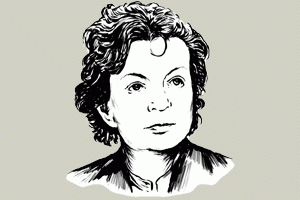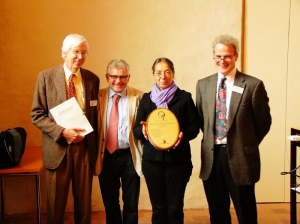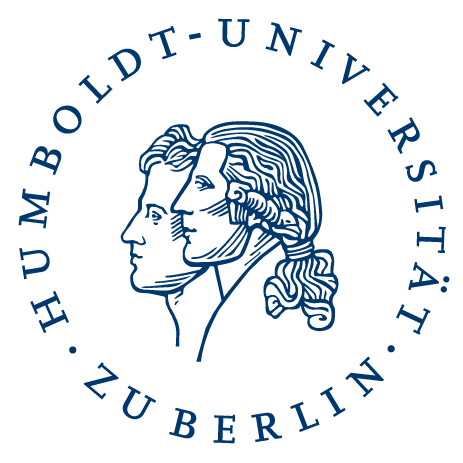Interview: the Hilda Geiringer Lecture
Annette Vogt and Wolfgang Härdle developed the Hilda Geiringer Lecture in 2013 with several purposes in mind. Prof. Dr. Annette Vogt works as a Senior Research Scholar at the Max Planck Institute for the History of Science and is an Honorary Professor at Humboldt-Universität zu Berlin. Prof. Dr. Wolfgang Härdle holds the Ladislaus von Bortkiewicz Chair of Statistics at Humboldt-Universität zu Berlin and is the spokesperson of IRTG 1792. They sat down with Anne Freese of GeCo-GenderConsulting to discuss the past and future of the lecture series, the accomplishments of Hilda Geiringer, and the importance of promoting women in science.

When and why did you decide to start the Hilda Geiringer Lecture as an annual event at your faculty?
When we established the Hilda Geiringer Lecture in 2013, several aims were on the agenda. With the Hilda Geiringer Lecture we wanted to offer a forum where young female scientists could present their newest research results in our field, i.e. in statistics, mathematics, theory of probability and their applications, risk research, and applied economics. Furthermore, the lectures held by those female scientists make them more visible to a broader audience. And finally the introduction of the Lecture Series heralded the inauguration of a special program to promote young female scientists: the establishment of a postdoc position. In the world of academia it has become a tradition to offer annual special lecture series where extraordinary scientists (less commonly female scientists) are invited to give plenary talks. These series are often named after a famous person who was important in the field, or who played a certain role in the history of the institution that’s introducing the lecture series. In mathematics, for example, our colleagues at the Mathematical Science Faculty in Adlershof are celebrating the annual Richard von Mises Lecture. In physics the German Physicists Society (Deutsche Physikalische Gesellschaft) has organised the Lise Meitner Lecture for 10 years now. The two lecture series are similar, before the plenary lecture (45 to 60 minutes) a presentation is given about the history of science with close reference to the namesake of the series. Therefore we had lots of inspiration to build on for our own series. Furthermore we established the postdoc position.
Why did you choose to name the lecture after Hilda Geiringer?
When we were thinking about a possible namesake the female historian of mathematics and science, Annette Vogt, helped us. She is the author of a book (2007) about the first female scientists at the Berlin University and in the institutes of the Kaiser Wilhelm Society. The book analyzes the long history from the first dissertation of a female student (in physics in 1899) until the capitulation of Nazi Germany. (Vogt, Annette. Vom Hintereingang zum Hauptportal? Lise Meitner und ihre Kolleginnen an der Berliner Universität und in der Kaiser-Wilhelm-Gesellschaft. Stuttgart: Franz Steiner Verlag, Pallas&Athene Bd. 17, 2007) Furthermore, Annette Vogt was familiar with the Richard von Mises Lectures as well as the Lise Meitner Lectures because she had given some historical talks there. She suggested that we name our lecture series after Hilda Pollaczek-Geiringer (1893-1973).
Hilda Pollaczek-Geiringer was a female mathematician who worked and taught on issues which remain relevant today. She worked at the Berlin University until 1933, when she was forced to leave the university and the country because of the Nazis. From 1927 to 1933 she was the only female adjunct lecturer for applied mathematics at the Berlin University. Together with Emmy Noether (1882-1935) in Göttingen from 1919 on, she was one of the only two female adjunct lecturers at any German university. Furthermore, Hilda Geiringer held an assistant position from 1921 to 1933 in the newly established Institute for Applied Mathematics at the Berlin University under the direction of Richard von Mises (1883-1953), who had founded the institute in 1920. Thus, we have a connection between the Hilda Geiringer Lecture at the Economics Faculty in the Berlin city center and the Richard von Mises Lecture at the Mathematical-Science Faculty in Adlershof.
What makes Hilda Geiringer such a brilliant example of a successful woman in science?
Hilda Geiringer worked in applied mathematics. After her marriage to the Viennese mathematician Dr. Felix Pollaczek (1892-1981) who worked in Berlin in an industrial research laboratory up until his emigration to France in 1933, she started publishing her articles as Hilda Pollaczek-Geiringer. She published articles about the mechanics of rigid bodies, the theory of elasticity, probability theory and insurance mathematics. She gave lectures and practical courses at the Berlin University, and together with Richard von Mises she ran the Seminar on Applied Mathematics at the Institute for Applied Mathematics. She worked successfully in research as well as in teaching, and thus she is a role model for our female students and young female scientists.
Because of the Nazi regime in Germany she had to go into exile, first to Brussels (1933-34), then to Istanbul (1934-1939), and finally in 1939 she escaped to the USA. Although the circumstances in exile were quite complicated and difficult, she was able to continue her research activities, and she taught at different universities. Therefore she is also a role model for a female scientist able to follow a career path under extremely difficult conditions. And last but not least, Hilda Geiringer was one of the very few female scientists who managed to be a mother and a researcher. She was a single mother to her daughter Magda (b. in 1921), a very rare position in the 1920s, even more so in the world of academia. And to emigrate with a young daughter was more difficult than escaping alone.
What can young female scholars and young female scientists learn today from Hilda Geiringer?
Young female scientists can learn many different things from Hilda Geiringer – they can learn to love mathematics and applied mathematics, to be able to apply mathematical methods to different practical problems and to solve them, to be interested in research topics and to be interested in teaching activities, to be open minded with regard to new topics and new cultures, to be curious throughout their lives, but also to be disciplined, persistent and strict. Without these characteristics she wouldn’t have been able to successfully juggle her life and her academic career as a female mathematician, mother and companion of her future husband Richard von Mises.
Why is it still necessary to support female scientists, even now, at the beginning of the 21st century?
Even today there are still only very few female scientists who work and teach successfully in the different scientific fields. So even in the 21st century we still have reasons to make the same demands that female scientists made in the 1920s: equal opportunities in research and teaching, equal payments, equal sharing in resources, equal career chances, and equal acknowledgement and honours. Therefore, we still need special programs to encourage and to support young female scientists and special panels to promote and to acknowledge them.
What are your ideas for the future development of the Hilda Geiringer Lecture?
In the future the Hilda Geiringer Lecture could become a lecture series of more than one organiser, thus commemorating that her activities in research and teaching were interdisciplinary. There are lots of different options if we were to organise the series this way: either in one faculty, or in a special unit (combination or network) of representatives from more than one faculty. Most important is that the Hilda Geiringer Lecture will be held each year, ideally at the beginning of the winter semester. And it is also important that the invited speakers who hold the plenary lectures and give the historical talks are all extraordinary female scientists and that their invitation will be planned well in advance. If the organisers also change each year, that would also need long-term preparation.
What are your suggestions for and visions for the future of this lecture?
The long-term invitation policy is important, otherwise we can’t invite prominent and outstanding female scientists to hold the plenary lecture. The same is true when inviting historians of science. If a network or research cluster (Verbund) were to be the organiser in the future, one could think about a program for the next 7 years (2019-2026), mirroring the funding of the research cluster.
If the lecture were to be organised by a faculty, and if there is more interest in the history of female scientists, the organisers could offer to display the special exhibition on female scientists at the Berlin University, which was shown first in 2010 in Adlershof and is still available, before and after the Hilda Geiringer Lecture. It would also be possible to think about special events, like readings by female authors on a topic related to the lecture series, or panel discussions and open forums.
Again, most important is that the Hilda Geiringer Lecture will be offered annually in the future, and that each year a prominent female scientist will be invited. This way the lecture series will be able to appropriately commemorate Hilda Geiringer as an outstanding female mathematician, as a female university teacher, a single mother and as a true companion who was able to combine family duties and scientific research. In the future. the relevance of applied mathematical methods will broaden beyond just statistical methods and the use of theory of probability. As such, remembering Hilda Pollaczek-Geiringer as a role model who was able to solve successfully practical problems thanks to the application of mathematical methods will become even more important.
Interview held by Anne Freese, GeCo-GenderConsulting.






